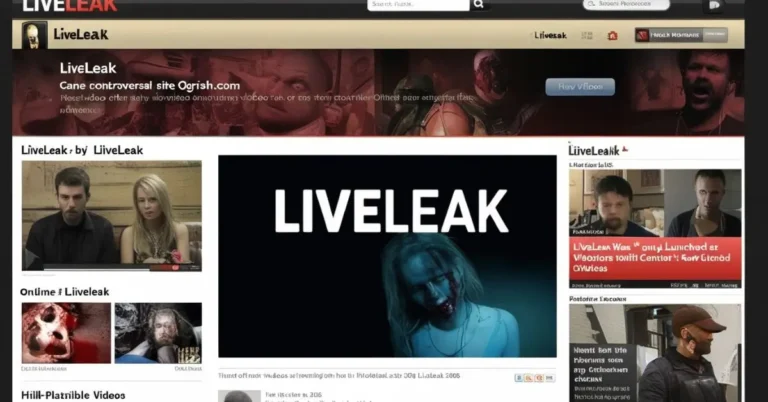In an era where information is available at the fingertips of millions around the world, platforms dedicated to the immediate dissemination of content have played a significant role in shaping how news and media are consumed. One such platform that gained considerable prominence is LiveLeak. This article delves into the origins, evolution, impact, and eventual decline of LiveLeak, examining its role in the digital media landscape and the broader implications for online content sharing and freedom of information.
Origins and Early Development
LiveLeak was launched in October 2006 by a group of individuals who aimed to create a platform where users could share uncensored, real-time videos. The site was a successor to the controversial video sharing platform, Ogrish.com, which had gained notoriety for hosting graphic content. LiveLeak sought to provide a space for raw, unedited footage from around the world, often focusing on newsworthy events and societal issues that were underreported by mainstream media.
The platform’s early development was characterized by a commitment to free speech and the unrestricted sharing of content. This ethos attracted a diverse user base, including journalists, activists, and ordinary individuals seeking to broadcast important events as they happened. LiveLeak’s interface allowed users to upload, view, and comment on videos, fostering a community around the exchange of uncensored information.
Content and Controversies
LiveLeak’s content was a double-edged sword. On one hand, it offered a unique perspective on global events. For example, the platform was known for its coverage of conflicts, such as the Iraq War and the Syrian Civil War, providing unfiltered views of the realities on the ground. This raw footage was invaluable for understanding complex situations that were often sanitized in mainstream media reports.
On the other hand, the platform’s commitment to minimal content moderation led to significant controversies. LiveLeak was frequently criticized for hosting graphic and distressing content, including violent acts and explicit scenes. Critics argued that such content could desensitize viewers to violence and suffering, while proponents maintained that it was essential for transparency and awareness.
One of the most notable controversies involved the release of videos depicting graphic violence, including execution footage and combat scenes. While these videos were often sourced from conflict zones and were intended to shed light on the harsh realities of war, their graphic nature drew significant criticism and raised ethical questions about the responsibility of content platforms in moderating such material.
Impact on Media and Society
Despite the controversies, LiveLeak had a substantial impact on media and society. The platform contributed to the democratization of information, allowing ordinary people to share their perspectives and experiences directly with a global audience. This shift challenged traditional media gatekeepers and empowered individuals to become citizen journalists.
LiveLeak also played a role in raising awareness about various global issues. For instance, its coverage of protests and uprisings provided insight into grassroots movements and the struggles faced by individuals fighting for change. In many cases, LiveLeak’s videos were used by traditional media outlets as supplementary material, further highlighting the platform’s influence on mainstream news.
However, the platform’s focus on sensational and graphic content also contributed to discussions about media ethics and the potential for exploitation. The debate over the balance between transparency and the responsible portrayal of distressing material became a central theme in discussions about LiveLeak’s role in the media landscape.
The Decline and Closure
LiveLeak’s decline began in the early 2010s, as the platform faced increasing challenges related to content moderation and user engagement. The rise of social media platforms such as YouTube, Facebook, and Twitter provided alternative avenues for sharing videos and news, often with more robust content moderation systems in place.
Additionally, the increasing scrutiny of online content platforms by governments and regulatory bodies placed pressure on LiveLeak to adapt its policies. The platform struggled to navigate the complex landscape of content regulation, which contributed to its decline in popularity.
In May 2021, LiveLeak officially shut down, marking the end of an era for a platform that had once been at the forefront of online content sharing. The closure was attributed to a combination of factors, including financial difficulties, changing user preferences, and the challenges of moderating a site with such a controversial history.
Legacy and Lessons Learned
LiveLeak’s legacy is multifaceted. On one hand, it represents a pioneering effort in the realm of uncensored content sharing and citizen journalism. The platform’s commitment to providing a space for raw, unfiltered footage contributed to important conversations about media transparency and freedom of information.
On the other hand, LiveLeak’s controversies underscore the complexities of managing online content and the ethical considerations involved. The platform’s experiences highlight the need for a balance between freedom of expression and the responsibility to prevent the dissemination of harmful or exploitative material.
The lessons learned from LiveLeak’s rise and fall are relevant for current and future content platforms. As digital media continues to evolve, the challenge of balancing transparency with ethical considerations remains a critical issue. Platforms must navigate the fine line between providing a space for open expression and ensuring that their content does not contribute to harm or exploitation.
Conclusion
LiveLeak’s journey from a revolutionary platform to its eventual closure offers valuable insights into the dynamics of online content sharing and the broader media landscape. While its legacy is marked by both significant achievements and controversial moments, the platform’s impact on media and society is undeniable. As we move forward, the experiences of LiveLeak serve as a reminder of the importance of responsible content management and the ongoing dialogue about the role of digital platforms in shaping public discourse.
By reflecting on LiveLeak’s history, we gain a deeper understanding of the challenges and opportunities that come with the digital age. The evolution of media platforms continues to be a dynamic and evolving field, and the lessons from LiveLeak will undoubtedly inform the development of future platforms and the ongoing quest for a balanced and ethical approach to online content sharing.

